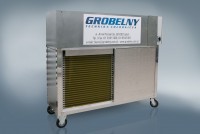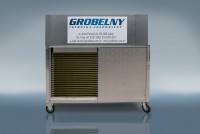/ Offer / Wood dryers
Condenser dryers
GROBELNY Condenser dryers
Condense wood drying is a modern, eco-friendly and energy efficient technology. Unlike in the case of the traditional drying process, humid and hot air – once it passed through the heap of wood – is not released into the atmosphere. The heat contained in the air mass is completely used to heat the dryer, while the low temperature water condensed in the unit is removed outside the room. The solution we used is the popular heat pump.
Advantages
The basic advantage of the condensing system offered by our company is the ability to obtain top quality wood – with no cracks, discolourations, or deformations, etc. This results from the lower temperature used in the drying process and the relatively low air flow speed in the chamber. Our condenser dryers are 100% eco-friendly and safe for their direct vicinity. Low investment costs. There is no need to build a boiler room. There is no need to provide permanent operators. Any room can be adjusted to become a drying chamber without the need to make any costly investments. Electricity consumption is similar to consumption by a traditional dryer. During the drying process, there is basically no need to heat up the chamber. Heating up of the drying room is necessary in two cases: before launching of the drying unit (initial temperature for soft wood is approx. +18°C, while for hard wood – approx. +28°C) and at the final stage of drying thick, hard wood. Except for the cases described above, you MUST switch off all additional heat sources in the drying room.
Disadvantages
The low temperature in the chamber in comparison to the traditional process prolongs the drying process by approx. 30% in the case of soft wood and by 50% in the case of thick elements of hard wood.
Requirements
Building partitions in the drying room should have good thermal insulation properties (at least 12 cm of Styrofoam or a PU equivalent.
Wood distribution in the drying room
Wood lying crosswise to the flowing air must fill up the entire cross section of the drying room as tightly as possible. If this is impossible, free spaces should be blocked with adequate partitions. Schematic diagram – cross section of the drying room
Basic principles of condensing drying
Once wood is inserted, the chamber is to be heated up, with circulation fans on, until the following temperatures are reached: minimum of +18°C (soft wood) or minimum of +28°C (hard wood). The time of exposure to the selected temperature is at least 24h. In the course of wood heating, the drying unit must be plugged to the power network. Notice: before the first unit activation, the relative aid humidity should not be lower than 90%rH for soft wood and 97% rH for hard wood. Thick elements of hard wood should be kept at least 24h at the humidity of approx. 100% rH. Drying should be performed according to detailed technological manuals, and if there are none – according to the rules placed on the chart supplied with the dryer. If the temperature goes too high, air venting should be switched off so that temperature stays below permissible values. Once wood is dry enough, the unit should be plugged off. Next, you should let wood cool down slowly for at least a few hours up to a few days. This is important for equalizing humidity across the entire mass and releasing tensions. The average time of drying wood down to an 8% humidity level is 12 days (soft wood) up to 30–60 days (hard wood). Shortening the cycle may result in wood fractures or sealing.
Condenser dryers are custom-made for soft or hard wood for chambers with capacity of 5–100 m3 of wood. Depending on their size, they might be mobile (on wheels) or stationary. Manual or semi-automatic control. Installed power from 2 kW to 30 kW.


